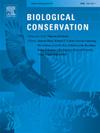A systematic map of hydropower impacts on megafauna at the land-water interface
IF 4.4
1区 环境科学与生态学
Q1 BIODIVERSITY CONSERVATION
引用次数: 0
Abstract
Hydropower plants have been developed globally to provide renewable energy, increase water supply and help with flood control. Meanwhile, hydropower impacts on riverscape and aquatic species are widely documented. However, little attention has been paid to impacts on large semi-aquatic animals such as crocodylians, turtles, and otters, which are prone to environmental changes associated with hydropower development. We conducted a systematic mapping of evidence documented in the published literature and synthesised the effects of hydropower development on semi-aquatic megafauna (i.e., semi-aquatic animals with a reported maximum body mass ≥ 30 kg). We identified 68 relevant impact records from 30 studies, which demonstrated that hydropower plants profoundly altered the habitats of semi-aquatic megafauna and affected their interactions with humans and domestic animals. Hydropower plants posed adverse impacts on the distribution, fitness, movement, nutrition, and reproduction of semi-aquatic megafauna. Positive impacts, such as increased suitable habitats and available food resources associated with land cover change, were also observed in some instances. Our study reveals a considerable information gap on effects of hydropower development at the land-water interface and underscores the gaps in current assessments, such as the lack of monitoring schemes that compare the situations of semi-aquatic species before and after dam construction. It also emphasises priority regions for monitoring and conservation schemes, particularly in tropic regions that are experiencing rapid hydropower development. We highlight the need to incorporate hydropower impacts on semi-aquatic animals into planning and management of renewable energy infrastructure for better informed decisions on energy production and biodiversity conservation.
水电对陆水界面巨型动物影响的系统地图
世界各地都在开发水电站,以提供可再生能源、增加供水和帮助控制洪水。与此同时,水电对河流景观和水生物种的影响也被广泛记录。然而,水电开发对鳄鱼、海龟和水獭等大型半水生动物的影响却很少受到关注,这些动物容易受到水电开发相关环境变化的影响。我们对已发表文献中记录的证据进行了系统的制图,并综合了水电开发对半水生巨型动物(即据报道最大体重≥30 kg的半水生动物)的影响。我们从30项研究中确定了68项相关的影响记录,这些记录表明水电站深刻地改变了半水生巨型动物的栖息地,并影响了它们与人类和家畜的相互作用。水电站对半水生大型动物的分布、适应性、运动、营养和繁殖产生不利影响。在某些情况下还观察到积极的影响,例如与土地覆盖变化有关的适宜生境和可用粮食资源的增加。我们的研究揭示了水电开发对陆水界面影响的相当大的信息差距,并强调了当前评估的差距,例如缺乏比较大坝建设前后半水生物种情况的监测方案。它还强调监测和保护计划的优先区域,特别是正在经历快速水电发展的热带地区。我们强调有必要将水电对半水生动物的影响纳入可再生能源基础设施的规划和管理,以便在能源生产和生物多样性保护方面做出更明智的决策。
本文章由计算机程序翻译,如有差异,请以英文原文为准。
求助全文
约1分钟内获得全文
求助全文
来源期刊

Biological Conservation
环境科学-环境科学
CiteScore
10.20
自引率
3.40%
发文量
295
审稿时长
61 days
期刊介绍:
Biological Conservation is an international leading journal in the discipline of conservation biology. The journal publishes articles spanning a diverse range of fields that contribute to the biological, sociological, and economic dimensions of conservation and natural resource management. The primary aim of Biological Conservation is the publication of high-quality papers that advance the science and practice of conservation, or which demonstrate the application of conservation principles for natural resource management and policy. Therefore it will be of interest to a broad international readership.
 求助内容:
求助内容: 应助结果提醒方式:
应助结果提醒方式:


